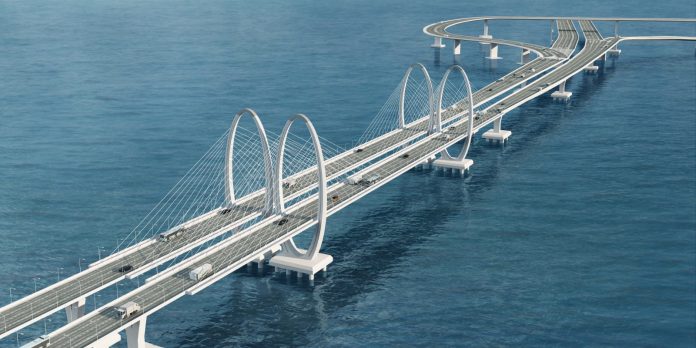Maharashtra State Road Development Corporation (MSRDC) was established as a wholly owned entity of the Government of Maharashtra in 1996.
MSRDC soon won huge appreciation for the rapid progress it made in constructing and completing 55 flyovers in the Mumbai region in a record time.
In its 27 years of existence, MSRDC has not only successfully built the mammoth Hindu Hrudaysamrat Balasaheb Thackeray Samruddhi Mahamarg but has also delivered many other state-of-the-art engineering marvels.
From India’s first six-lane concrete, high-speed, and access-controlled expressway connecting two major cities of Mumbai and Pune to the country’s first cable-stayed sea link bridge, the MSRDC has been managing mega projects since its inception.
MSRDC pioneered the development of access-controlled greenfield expressway projects in India. In the absence of private sector capacity at that point in time, MSRDC demonstrated that state entities could deliver transformational infrastructure projects in record time.
Mumbai-Pune expressway stands as testimony to it.
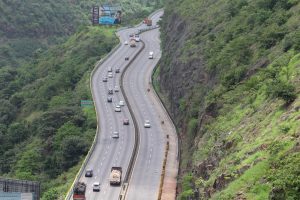
The construction of the 95 km Mumbai-Pune Expressway under the stewardship of the MSRDC began in 1998 and was operationalised in 2002.
Developed as India’s first six-lane access control expressway, the project was completed in record time and at half the cost that some private entities estimated when they bid.
After a bit of a lull, MSRDC was reinvigorated in 2015 and embarked upon the task of building what is currently India’s longest greenfield expressway.
In 2015, the Maharashtra government led by then Chief Minister Shri Devendra Fadnavis announced and approved the construction of a greenfield expressway connecting the state capital, Mumbai, with Nagpur (the state’s second capital located in the easternmost part).
MSRDC was chosen as the nodal agency constructing the Samruddhi Mahamarg.
From conceptualising the alignment to land acquisition, securing funding, tendering packages and construction, the Samruddhi Expressway was completed in record time. It is widely regarded as the ‘gold standard’ in greenfield expressway development.
The 701 km Expressway that traverses ten key districts of the state and indirectly connects 14 other districts of the state was explicitly aimed at opening up new vistas for the state.
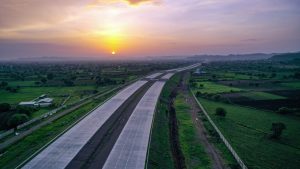
The expressway connects economic hubs, including the country’s largest container port, JNPT in Mumbai and a new airport coming up in Navi Mumbai. It will provide access to several industrial and economic centres through 24 interchanges.
The project was not merely envisaged as connecting two places but was envisioned as an economic corridor. A key vision of the expressway project is to develop 18 townships located at strategic intersections at a distance of 30 to 40 km from each other.

Usually, when a highway is developed, we know that interchanges gradually emerge as economic hotspots. But instead of that process happening in a spasmodic way, MSRDC has integrated the township development plan into the expressway project design to unlock the best value.
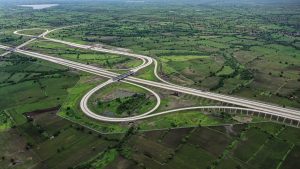
The new townships will encompass essential facilities, including schools, Industrial Training Institutes (ITIs), skill development centres, institutes providing technical education and higher education, hospitals, police stations, playgrounds, open spaces, parks and sports complexes.
Building on the success of the Samruddhi Expressway, MSRDC has now embarked on constructing at least five greenfield expressways crisscrossing the state at an estimated total investment of Rs 3 lakh crore. The greenfield expressway under various stages of execution includes the 180 km Jalna- Nanded expressway, the 820 km Nagpur-Goa Shaktipeeth expressway and the 388 km Konkan Expressway connecting Mumbai- Sindhudurg.
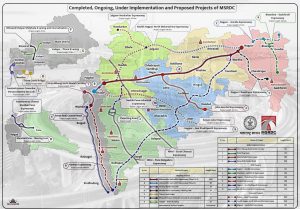
Other Projects
Another key project that MSRDC is working on is the ‘missing link’ project on the Mumbai-Pune expressway, which is set to be completed by mid-2024. The ‘missing link’ will reduce the commute time by 30 minutes between the two cities.
With the ‘missing link’, the MSRDC also aims to solve an annual worry during the monsoon — traffic gridlocks at Khandala due to falling boulders and morum from hillocks that flank the road.
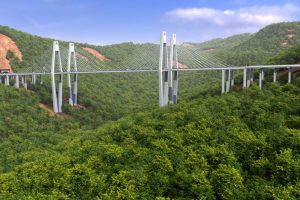
The Rs 6,695-crore project is an engineering marvel. The ‘missing link’ will feature an 840-metres-long viaduct (60 metres height), then it enters a 1.75-km-long tunnel, then goes over the 640-metres-long cable-stayed bridge (around 100 ft height) and after that enters another 8.9 km-long tunnel.
A cable-stayed bridge is a crucial part of the project. MSRDC designed it to withstand wind speeds of 70 metres per second or 252 km per hour. A prototype of the bridge’s design was put to wind tunnel testing in Denmark, California, Delhi, and Hyderabad. It was a huge effort. The wind tunnel testing had to be done as the bridge over the Sahyadri Valley. The valley has unique weather patterns with varying wind patterns.
The tunnelling work is complete, and some work on viaducts is pending.
MSRDC is now developing Versova-Bandra Sea Link, which is set to be another iconic project in the city of Mumbai that is 17 km in length. This new bridge will connect Versova, a neighbourhood in the suburb of Andheri, to the Bandra–Worli sea link in Bandra as part of the coastal road.
The 8-lane sea link will reduce congestion on the Western Express Highway and the Western Line of the Mumbai Suburban Railway, which is expected to cut down commute time for Mumbaikars from over 90 minutes to 10 minutes.
The key elements of the bridge structure include one main viaduct, a 300-m long cable-stayed bridge, three balance cantilever bridges and four connectors.
Another important urban infrastructure project that MSRDC is pursuing Is the Pune Ring Road.
The Pune Outer Ring Road, spanning 136.80 km and to be constructed at an estimated cost of over Rs 15000 crores, will be an upcoming access-controlled expressway designed by MSRDC. This expressway is envisioned as a circular route alignment encircling Pune City,
MSRDC has also embarked upon the Virar-Alibaug Multi-Modal Corridor, an access-controlled expressway that will connect Virar in Palghar district with the picturesque coastal town of Alibaug in Raigad district, passing through Thane. The proposed corridor seeks to integrate various transportation modes, such as buses, BRT, metro rail, and cars, alongside essential utilities like water, sewage, and gas lines within the same Right of Way.
The corridor has been envisaged to augment connectivity to proposed growth centres like Virar, Bhiwandi, Kalyan, Dombivali, Panvel, Taloja and Uran, situated in the Mumbai Metropolitan Region (MMR), thereby alleviating the burden on Mumbai city.
MSRDC’s success has been fashioned by its inspiring leadership and highly skilled team of engineers and employees.
MSRDC has developed a lean, efficient, contemporary organisational structure, acquired the necessary technical skills and developed an enterprising spirit capable of supporting decentralised decision-making.
MSRDC’s project has been meticulously planned, taking into consideration the needs of both citizens and the state. MSRDC’s upcoming projects will not only enhance the visual landscape but also transform various regions of the state into more modern and accessible areas.
It will continue to script iconic and mega infrastructure projects for Mumbai and Maharashtra and play a pivotal role in Maharashtra’s march to becoming India’s first trillion-dollar economy.


